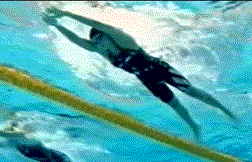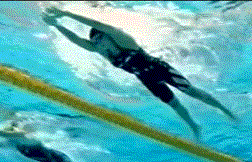HOW CHAMPIONS DO IT
Researched, produced, and prepared by Brent S. Rushall,
Ph.D., R.Psy.

REBECCA SONI AT 160 m OF HER WORLD RECORD GOLD MEDAL 200 m BREASTSTROKE RACE AT THE 2008 BEIJING OLYMPIC GAMES
Rebecca Soni's time for this Olympic Gold Medal swim was 2:20.22. This sequence was taken from a slow-motion video clip.
This stroke analysis includes a moving sequence in real time, a moving sequence where each frame is displayed for .5 of a second, and still frames.
The following image sequence is in real time. It will play through 10 times and then stop. To repeat the sequence, click the browser's "refresh" or "reload" button.

The following image sequence shows each frame for half a second. It will play through 10 times and then stop. To repeat the sequence, click the browser's "refresh" or "reload" button.

At the end of the following narrative, each frame is illustrated in detail in a sequential collage.
Notable Features
- Frame #1: This position marks the end of the swimmer's direct backward kicking action. As well it is the end of the hands being together. This is an important stage because it involves very little, if any, propulsion gained from bringing the legs together. The hands open to get to a position where propulsive forces can be developed. [Some people would argue that an outward sculling action would produce a component propulsive force but this swimmer does not scull nor does she perform a long enough action to produce such force. The amount of movement outward of the hands would only move water, and is of insufficient magnitude to compress the water appropriately.] This lack of force production marks a major inertial lag that is involved with this stroke. If the swimmer could minimize that inertial lag, then stroking efficiency would be improved. The swimmer is in excellent streamline.
- Frames #2 and #3: The hands slide sideways and the feet come together.
- Frame #4: The hands have reached shoulder width apart and begin to be repositioned so that direct backward propulsive forces can be developed.
- Frame #5: The elbows bend and the upper arms are abducted as repositioning and the development of propulsion proceeds. The head begins to be lifted forward. The body and legs trail in a streamlined position.
- Frame #6: As abduction of the upper arms occurs, the propulsive surfaces of the arms move further to the side. This is not a result of a deliberate movement of the hands to describe some path, but an artifact of abduction. To all intents and purposes, the swimmer is attempting to pull directly forward. The head continues to rise.
- Frames #7 through #9: The upper arms continue to abduct. The arms are pitched at an angle so that both horizontal and vertical force components are created. The vertical component supports the rising head and leaves the trunk and legs to trail in a streamlined position. The lower back begins to hyperextend.
- Frame #10: The head has risen out of the water. The upper arms approach adduction and the lower arms and hands increase their pitch to decrease the vertical force component. [Looking at this single frame would make it difficult to discern if it represented breaststroke or butterfly swimming.]
- Frame #11: The final phase of propulsion occurs as the upper arms begin to adduct. The lower back arches (hyperextends) more to raise the head above the water surface level for inhalation.
- Frame #12: Propulsion from the arms is completed. The hands do not sweep in and around under the upper chest, but rather slice directly inward and forward from this completion position. Such an action reduces energy-absorbing turbulence creation and fosters a faster recovery because of the shorter distance travelled. The legs begin to flex at the knees as part of initiating the kicking action. However, that flexion also assists in maintaining streamline which mainly is disrupted by the angled trunk presentation as frontal resistance.
- Frame #13: The hands continue to slice forward and in. The heels stay close to the surface as the knees bend.
- Frame #14: A subtle timing of several stroke parts begins to occur in this frame. That timing minimizes the resistance that is part of complying with the stroke's rules. The hands come together well in front of the swimmer and lead the shoulders and head forward and down. As that occurs, the back begins to straighten and the hips flex. That trunk movement raises the hips and begins to present the thighs as bodily parts creating frontal resistance as the lower legs are drawn up.
- Frames #15 through #17: The arms, head, and trunk are thrust forward into a flat position as the legs are drawn up. Frame #17 is the start of the propulsive kick. The legs do not develop "the biggest kicking action possible". Rather, they are positioned to provide the fastest most direct kick, which results in the preparation and propulsive phases being of the shortest duration. Traditional kicking inefficiencies (e.g., drawing up so that thighs are virtually vertical; kicking out-and around, emphasizing the legs coming together) are not shown in this movement pattern.
- Frame #18: The kick's propulsion occurs when the arms, head, and trunk are in a streamlined position. This feature is common amongst modern breaststrokes and departs from the technique of over a decade ago where the body and arms would be driven forward as the legs kicked backward.
- Frames #19 and #20: The kick is completed as a directly backward action. The legs do not start coming together until extension of the knees is completed. The maintenance of streamline of the body parts not involved in kicking is an essential part of this depiction of modern breaststroke swimming.
- Frame #21: The swimmer repeats the movement cycle that is depicted in Frames #1 and #2.

Rebecca Soni displays several features that advance the general understanding of breaststroke swimming.
- Propulsion is developed when the arms/hands are shoulder width apart. That propulsion uses the total arm surface to apply force backward. Propulsive forces are developed by abduction and some adduction of the upper arms rather than with the hands and lower arms.
- The recovery of the hands from the end of propulsion is a direct slicing in and forward movement. There is no exaggerated inward scull that traditionally was used to lift the head and shoulders to breathe.
- The breathing action begins as the arms propel. An arm force component is used to lift the head and shoulders.
- The forward and down driving action of the recovering arms and post-inhalation shoulders and torso occurs as the legs are drawn up as the preparatory movement for kicking.
- The kick begins from a comfortable (and not exaggerated) contracted position. The kick is fast and direct and eliminates lateral force components. It occurs when the arms, head, and trunk are streamlined and thus, resistance is minimized.
These summarized features of Rebecca Soni's technique are worthy of emulation.
Some significant factors that signal changes in breaststroke principles are evident in Rebecca Soni's technique.
- Her shorter direct propulsion and recovery arm path means that faster arm stroking is possible. As well, the leg kick has less flexion of the hips and knees which produces quicker kicking.
- It is very likely that big leg kicks not only produce greater kick propulsion but also produce even greater resistance causing the resistance to propulsion ratio to decrease overall effect. Consequently, the shorter leg compression reduces resistance while the kick is still effective producing an increased direct propulsive effect. [Bigger kicks do not necessarily produce greater effectiveness.]
- The shorter arm stroke locus of movement and size of kicking action increases the stroke rate of the total breaststroke action producing more propulsion per unit of time with less resistance which results in faster swimming.
These factors also are emerging in other modern male and female breaststroke swimmers.
Return to Table of Contents for this section.

![]()



![]()